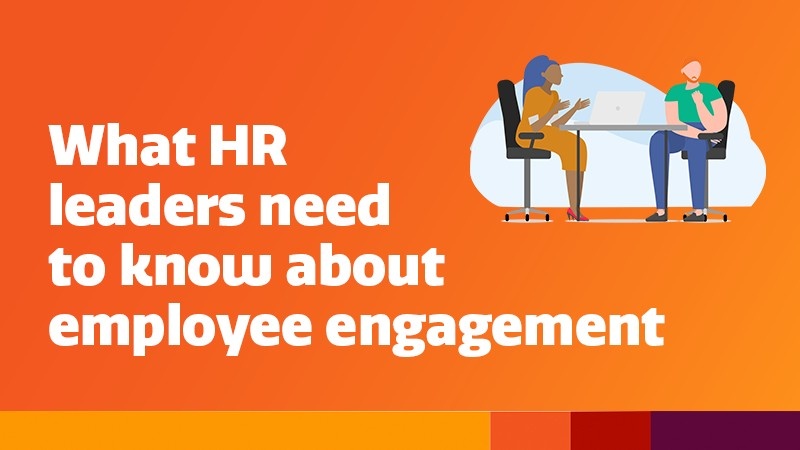The Key to Unlocking True Employee Engagement
-1.png?width=489&name=key%20(1)-1.png)
No doubt you’ve seen the reports about dismal employee engagement. Gallup says engagement has dropped for the first time in more than a decade. Only a third of workers say they are engaged in the work and a troubling 16% say they are actively disengaged.
Certainly, a lot has changed for everyone over the past two years. The pandemic has taken a toll on nearly every industry and caused employees to rethink their lives. The Great Resignation of 2021 led to record turnover as millions left their jobs, leaving companies short-handed during a tight labor market and high competition for skilled workers.
A lack of engagement at work not only hurts efficiency and productivity but also means that even more turnover is likely ahead.
What’s Causing Such High Disengagement
With quit rates at a record 20-year high, it’s important to understand what’s driving such actions. In March 2022, the Pew Research Center released the latest results from its tracking poll on turnover. While the majority of employees said they left their jobs in 2021 due to pay rates, an equal number cited a lack of advancement opportunities and other attributes that affected their engagement.
Top Reasons Why U.S. Workers Left Their Jobs
Source: Pew Research Center
- 63% Pay too low
- 63% No opportunity for advancement
- 57% Felt disrespected at work
- 48% Child care issues
- 45% Lack of flexibility in scheduling
- 43% Poor work benefits, such as PTO and health insurance
What did they find in their new jobs? More than half said they are now earning more money, have more opportunities for advancement, flexibility in hours, and are better able to balance family responsibilities. For employers wanting to improve engagement, it’s a clear signal of what’s important to workers. When you can meet employee needs, you will improve engagement.
Failing to improve engagement has serious consequences. Even if employees don’t resign, they may do something worse: quit but stay on the job and simply stop being productive. Employees that are actively disengaged are not just unproductive, they can also drive top performers away from your company.
The Benefits of Employee Engagement
How important is engagement when it comes to performance? It’s crucial and impacts nearly every aspect of your operational effectiveness. 50 years’ worth of data across hundreds of thousands of companies has demonstrated that engaged teams get better results.
Engaged teams outperform their peers in a variety of ways, including:
- 18% higher productivity
- 23% higher profitability
- 10% high customer loyalty
Engaged teams also reduce several key factors that inhibit a company’s ability to grow. Compared to peers, engaged companies have:
- 81% lower absenteeism
- 18% less turnover in high turnover industries
- 43% less turnover in low turnover industries
- 28% less theft (shrinkage)
- 62% fewer safety incidents
- 41% fewer quality defects
You simply cannot underestimate the importance of an active and engaged workforce in meeting your organizational goals. When employees are engaged, everything improves.
The benefits are clear. So, how do you make it happen in your workplace?
How to Create a Highly Engaged Workforce
Creating an engaged workforce starts at the top. Companies must commit to an employee-centric strategy to optimize performance and retain workers.
The people behind the Best Place to Work awards in nearly 50 cities nationwide is a company called Quantum Workplace. They identify the attributes that drive employee engagement for maximum impact:
- Leaders are committed to making their organization a great place to work.
- Leaders value people as their most important resource.
- Employees trust leadership to guide the company and make the right decisions.
- Employees understand how they fit into company goals and the future.
- The organization invests in making employees more successful.
These core tenants must be embedded in company culture and decision-making and communicated frequently.
1. Commitment to a Great Work Environment
We all know that positive work culture is important, just as a toxic culture is bad. However, it’s not just about creating a good place to work. Engagement grows exponentially in a great work environment.
This only happens though when the leaders at the top of the organization are driving that culture and reinforcing it in the decisions they make.
Leaders also have to walk the walk. For example, managers can’t expect employees to work late to finish jobs day after day while the boss leaves early. Leaders can’t boast about record profits and then eliminate matching contributions to employee 401(k) plans. It takes a commitment to building a strong culture and staying true to core values.
2. People Come First
Highly-engaged companies put people first. They demonstrate it in their policies and the way they treat people. They solicit feedback, listen, and act. They show appreciation and recognize when teams, departments, and individuals make important contributions.
In short, they invested in their teams.
Putting people first doesn’t mean, however, that leaders are unabashed cheerleaders. Managers need to provide regular, real-time feedback and actively look for coaching moments to help improve performance. Employees need to know when they are exceeding expectations and when they are falling short. Coaching and training are an investment in helping employees grow and remain engaged.
3. Trust in Leadership and Positioned for Success
Besides caring, employees also want leaders to trust that leadership is steering the ship in the right direction. The best inspire confidence in the future so that employees can be optimistic about what’s ahead.
Everybody wants to be part of a winning team. Driving engagement means fostering that winning spirit, celebrating the wins, and keeping team members focused on organizational goals. When people truly believe the company is thriving amid strong leadership, they are more engaged and invested in the outcome.
4. Understanding Roles
There’s a great quote in business, although the author is unknown. It goes like this: “Valuable work comes from people who know how valuable they are.”
Regardless of who said it, the adage is correct. When employees know how what they do connects to organizational goals, they have a better understanding of the importance of their work. Leaders must ensure employees know how their job fits into the bigger picture and aligns with company goals.
Employees also want to know how their role within the company can evolve as opportunities arise. Workers that see a clear pathway for career advancement and know what it takes to get rewarded are more engaged.
5. Training and Upskilling
At the same time, employees expect organizations to invest in training and coaching. Learning new skills not only makes employees more adept in their current position, but they are also gaining educational opportunities that can help them grow in their careers.
This is especially true for younger workers. Millennials are now the largest group of employees in the workplace, making up more than a third of the U.S. labor force, already outnumbering baby boomers. By 2025, millennials are forecast to represent 75% of the global workforce. What’s the number one thing this group says is at the top of their list when accepting a new job? 84% said an employer’s professional development and training are crucial.
Unfortunately, the majority of companies are falling short of expectations. Only half of Millennials feel their employer is helping them improve their skills, according to a Harris Poll on behalf of the American Staffing Association.

Lessons in Leadership and Engagement During the Pandemic
We learned a lot about managing and agility during the pandemic. Companies were forced to adapt in new ways and innovate with little information. The companies that thrived were the ones that put people first.
Business leaders didn’t know how being thrust into a work-from-home environment would work for the company. Yet, most executives believe it was a success. More than half of executives surveyed by PwC said productivity improved with remote work. Another 34% said they saw no drop-off in productivity.
While companies may have been forced to provide flexibility and trust their employees to do the right thing, they were rewarded in ways they might not have envisioned. By accommodating workers’ health and family needs during the pandemic, companies demonstrated both trust and commitment.
Rather than embracing legacy leadership models where managers were trained not to get too close to their employees, effective leaders worked hard to deepen their relationships. They demonstrated empathy. Many took extraordinary measures to keep them safe and employed.
These lessons should not be lost. When employees believe their employer cares for them and will work with them to overcome work and life challenges, it fuels loyalty and improves engagement.
Another important lesson revolved around transparency and honesty. During the early days of COVID, things changed rapidly. Managers were forced to make far-ranging decisions amid a lack of facts about the outcomes and with little time to think them through. When new information surfaced, they often had to change directions again.
Leaders that were transparent and honest in their decision-making accelerated trust even when decisions needed to be changed. Leaders learned it was OK to admit when they didn’t know what to do and asked for help. It not only helped employees as they navigated through the uncertainty, but it demonstrated an openness that had rarely been seen before.
When employees came up with suggestions and innovative solutions amid the crisis, leaders were more open to embracing them and implementing them. This, in turn, created increased engagement.

Giving Employees a Sense of Purpose
Organizations that listen to their employees, value their input, care about them, and provide growth opportunities are on the way to improving engagement. However, it goes beyond that.
The most committed employees have found deeper meaning in their work: a sense of purpose.
Employees want to know that the work they’re doing is providing more than just a paycheck or making money for someone else. They want to make a difference.
A recent article in the Harvard Business Review tells the story of Gerry Anderson, President of DTE Energy. When the Recession hit in 2008, Anderson knew he needed to get more engagement and productivity from his workers. They needed new thinking and a fresh approach.
Fortunately for Anderson, one of DTE’s board members was retired army major general Joe Robles, who also happened to be the CEO of USAA at that time. He invited Anderson to visit USAA’s call centers. Familiar with stories about the poor culture, high turnover, and disengaged workers in the call center environment, he expected to find the same. He was shocked to see positive and fully engaged employees working together and going above and beyond for customers.
Robles told him that a leader’s most important job is to connect people to purpose.
At USAA, employees go through a four-day orientation as part of the onboarding process and have regular team meetings to reinforce the mission: to provide extraordinary service to the military members and their families that have sacrificed for our country. It’s this sense of purpose that drives USAA employees. It’s more than just a job. It‘s a way to honor and serve those that had served them.
You may be thinking that’s a noble goal, but that doesn’t apply to other companies.
When Anderson returned, he thought about the impact his company made on others’ lives and created a video showing how the work done by the company’s truck drivers, plant operators, repair crews, and employees impacted their community. The video described how providing energy allows teachers, doctors, and factory workers to do their jobs and take care of others.
When employees viewed the video, they gave it a standing ovation. Some were moved to tears. Employees understood for the first time the important role they played in empowering their community. It gave them a sense of purpose.
DTE redesigned its company culture, training programs, meetings, and employee management practices to consistently reinforce the mission. They also aligned incentives with the mission.
The results speak for themselves. Engagement scores grew substantially. The company was named a Gallup Great Workplace five years in a row. And, the company’s stock grew by 300%.
When employees see the value in the work they do, they realize they’re working for the greater good. It’s a powerful motivator.
Improving Employee Engagement
Improving employee engagement is key to creating sustainable growth. When employees are engaged, productivity improves and companies excel.
Understanding what employees want from their employers and taking proactive steps to help fuel employees’ motivations can be a defining factor in your success.
Share this
You May Also Like
These Related Stories

33 Trust-Building Questions to Ask Your Employees





.png?width=534&height=632&name=blog%20ad%20(1).png)
